Foaling season is underway for most breeding farms. Janné Stewart, breeding manager at Masterson Farms, helps deliver about fifty or so foals each spring. Spring is a busy time on the farm, with three breeding stallions; but for about five months, on any night when a Foal Alert monitor goes off in her apartment, it could be an all-nighter for her.
She brings the farm’s broodmares close to the barn in stages based on their due dates. Four weeks from their delivery date the mares start getting extra special attention. They are housed in large foaling stalls with two doors and extra fluffy bedding, which includes wheat straw, offering extra cushion for the mare and foal. Stewart keeps a close watch on a mare’s progress toward delivery. She stops using the automatic waterers in the stalls and uses buckets instead so she can monitor water intake. The mares are fitted with Foal-Alert monitors, a magnet device that comes apart when the foal starts to be born. She checks the rump muscles regularly for relaxation of the musculature in the tail and pelvic area, which usually starts about three weeks in advance of the birth. The more flaccid the area, the closer to foaling time the mare is. By the time she’s ready to foal, her rump is like Jello and jiggles when you poke the muscles around her tail. Stewart also regularly uses the Predict-a-Foal kit, which measures calcium and magnesium in a mare’s early milk secretions and can predict foaling within a number of hours. Stewart has found the kits to be a reasonably effective indicator of whether she will have to be up in the middle of the night delivering a foal, although some of the mares hold on to their foals regardless of the predictions!
Stewart keeps a foaling cart ready, equipped with baby blankets for the newborns, pink for the fillies and blue for the colts. The cart carries all the standard foaling equipment, like towels, gloves, enemas, and antiseptic solution for dipping navels; the cart is also stocked with emergency equipment and medications for the rare times those are needed. She keeps the cart at the foaling stalls, along with extra halters and lead ropes. When delivery seems close, Stewart keeps the mares’ tails braided and wrapped for cleanliness. She also keeps the udder and perineal areas clean with Ivory dish soap which is very mild and washes off easily.
All of her preparation pays off. Usually in the middle of the night the Foal-Alert alarm goes off, sometimes more than one a night, and Stewart, who lives on-site, heads to the foaling stalls. The first things she checks for are two feet and a nose, and that they are in the correct position, feet coming out with nose on top, face down. She once had a situation where she did indeed have two feet and a nose, but the hooves were upside down meaning the foal was on its back. That was bad news, because the foal couldn’t come out it that position. She and the mare worked together to get the foal turned over and all was eventually well. An advantage of the Foal-Alert system is that someone can be at the delivery in time to help a mare with any problem.
Dr. Colin Anderson, veterinarian for the farm, says, “There’s no ‘wait and see’ with mares. If they look like they’re having trouble, you need to jump to action, and definitely call a veterinarian.” Dystocia is the term for troubled labor. Anderson says there no such thing as a ‘mild’ dystocia.” Any troubled labor is cause for immediate action to help the mare. A normal foal delivery is quick, usually in about fifteen or twenty minutes, sometimes thirty minutes. Anything longer than thirty minutes is likely to cause problems for the foal, and forty five minutes or more starts to spell disaster for both.
Dystocias are not common, but when they happen, timing is critical!
After the foals are born, Stewart lets the umbilical cord break on its own and then dips the stump in a chlorhexidine solution; she dips the stump a few more times during the first day. Within minutes, she starts toweling the foal, beginning the foal imprinting process, based on the work of Dr. Robert Miller. She works over the foal’s entire body, flexing the neck, rubbing the ears, and performing other procedures which are designed to make the foal accepting of humans. Stewart feels that this process makes her foals very easy to work with, especially later at weaning time when they are stressed and a little panicky. The process takes her a while, usually about two hours per foal, and it requires a cooperative mare. Mares can become very aggressive about new foals. Some mares don’t tolerate her presence and the process might be abbreviated, but Stewart feels some contact is better than none. Safety is key during this time, and the two doors on the foaling stalls are handy to have. She leaves the stall doors unlatched, and positions herself just inside a door for a quick exit if necessary.
Stewart mostly does not try to help a foal nurse, because it seems to cause more problems than it helps. Foals need their mother’s colostrum in the first few hours after birth, and they will usually nurse by three hours. However, in cases when it’s clear some intervention is needed, instead of pushing the foal to the mare and trying to put it in the right position (which doesn’t work very well), it’s better to position the mare. Other help a foal might need is an enema. She watches for the first bowel movement, which usually happens without a problem. However, the things to look for in a new foal is “flagging” and aggressive wringing of the tail and tossing the head, which are signs of constipation and need for an enema.
One other responsibility at foaling time is checking the placenta. Stewart checks it carefully for every mare even if it seemed to be expelled without any problems. Even a small torn piece left inside the mare can cause serious problems like laminitis.
Last year Stewart had an unexpected surprise. A foal was born prematurely while the mare was still out with the herd. She found the mare in the pasture aggressively defending her baby from the rest of the mares. All turned out well in that situation, but mare owners should be aware that there could be dire consequences for a foal born outside in a broodmare herd situation. Sometimes expectant mares “steal” foals from other mares. This is extremely dangerous for the foal, as the expectant mare can’t nurse the foal. Since both mares were pregnant, it might go unnoticed that the foal is with the wrong mother until it’s too late for the foal.
Most mares and foals get through the natural birth process quickly and easily. Within just a few days the mares and babies are outside, kicking up their heels in the spring sunshine.
She brings the farm’s broodmares close to the barn in stages based on their due dates. Four weeks from their delivery date the mares start getting extra special attention. They are housed in large foaling stalls with two doors and extra fluffy bedding, which includes wheat straw, offering extra cushion for the mare and foal. Stewart keeps a close watch on a mare’s progress toward delivery. She stops using the automatic waterers in the stalls and uses buckets instead so she can monitor water intake. The mares are fitted with Foal-Alert monitors, a magnet device that comes apart when the foal starts to be born. She checks the rump muscles regularly for relaxation of the musculature in the tail and pelvic area, which usually starts about three weeks in advance of the birth. The more flaccid the area, the closer to foaling time the mare is. By the time she’s ready to foal, her rump is like Jello and jiggles when you poke the muscles around her tail. Stewart also regularly uses the Predict-a-Foal kit, which measures calcium and magnesium in a mare’s early milk secretions and can predict foaling within a number of hours. Stewart has found the kits to be a reasonably effective indicator of whether she will have to be up in the middle of the night delivering a foal, although some of the mares hold on to their foals regardless of the predictions!
Stewart keeps a foaling cart ready, equipped with baby blankets for the newborns, pink for the fillies and blue for the colts. The cart carries all the standard foaling equipment, like towels, gloves, enemas, and antiseptic solution for dipping navels; the cart is also stocked with emergency equipment and medications for the rare times those are needed. She keeps the cart at the foaling stalls, along with extra halters and lead ropes. When delivery seems close, Stewart keeps the mares’ tails braided and wrapped for cleanliness. She also keeps the udder and perineal areas clean with Ivory dish soap which is very mild and washes off easily.
All of her preparation pays off. Usually in the middle of the night the Foal-Alert alarm goes off, sometimes more than one a night, and Stewart, who lives on-site, heads to the foaling stalls. The first things she checks for are two feet and a nose, and that they are in the correct position, feet coming out with nose on top, face down. She once had a situation where she did indeed have two feet and a nose, but the hooves were upside down meaning the foal was on its back. That was bad news, because the foal couldn’t come out it that position. She and the mare worked together to get the foal turned over and all was eventually well. An advantage of the Foal-Alert system is that someone can be at the delivery in time to help a mare with any problem.
Dr. Colin Anderson, veterinarian for the farm, says, “There’s no ‘wait and see’ with mares. If they look like they’re having trouble, you need to jump to action, and definitely call a veterinarian.” Dystocia is the term for troubled labor. Anderson says there no such thing as a ‘mild’ dystocia.” Any troubled labor is cause for immediate action to help the mare. A normal foal delivery is quick, usually in about fifteen or twenty minutes, sometimes thirty minutes. Anything longer than thirty minutes is likely to cause problems for the foal, and forty five minutes or more starts to spell disaster for both.
Dystocias are not common, but when they happen, timing is critical!
After the foals are born, Stewart lets the umbilical cord break on its own and then dips the stump in a chlorhexidine solution; she dips the stump a few more times during the first day. Within minutes, she starts toweling the foal, beginning the foal imprinting process, based on the work of Dr. Robert Miller. She works over the foal’s entire body, flexing the neck, rubbing the ears, and performing other procedures which are designed to make the foal accepting of humans. Stewart feels that this process makes her foals very easy to work with, especially later at weaning time when they are stressed and a little panicky. The process takes her a while, usually about two hours per foal, and it requires a cooperative mare. Mares can become very aggressive about new foals. Some mares don’t tolerate her presence and the process might be abbreviated, but Stewart feels some contact is better than none. Safety is key during this time, and the two doors on the foaling stalls are handy to have. She leaves the stall doors unlatched, and positions herself just inside a door for a quick exit if necessary.
Stewart mostly does not try to help a foal nurse, because it seems to cause more problems than it helps. Foals need their mother’s colostrum in the first few hours after birth, and they will usually nurse by three hours. However, in cases when it’s clear some intervention is needed, instead of pushing the foal to the mare and trying to put it in the right position (which doesn’t work very well), it’s better to position the mare. Other help a foal might need is an enema. She watches for the first bowel movement, which usually happens without a problem. However, the things to look for in a new foal is “flagging” and aggressive wringing of the tail and tossing the head, which are signs of constipation and need for an enema.
One other responsibility at foaling time is checking the placenta. Stewart checks it carefully for every mare even if it seemed to be expelled without any problems. Even a small torn piece left inside the mare can cause serious problems like laminitis.
Last year Stewart had an unexpected surprise. A foal was born prematurely while the mare was still out with the herd. She found the mare in the pasture aggressively defending her baby from the rest of the mares. All turned out well in that situation, but mare owners should be aware that there could be dire consequences for a foal born outside in a broodmare herd situation. Sometimes expectant mares “steal” foals from other mares. This is extremely dangerous for the foal, as the expectant mare can’t nurse the foal. Since both mares were pregnant, it might go unnoticed that the foal is with the wrong mother until it’s too late for the foal.
Most mares and foals get through the natural birth process quickly and easily. Within just a few days the mares and babies are outside, kicking up their heels in the spring sunshine.











